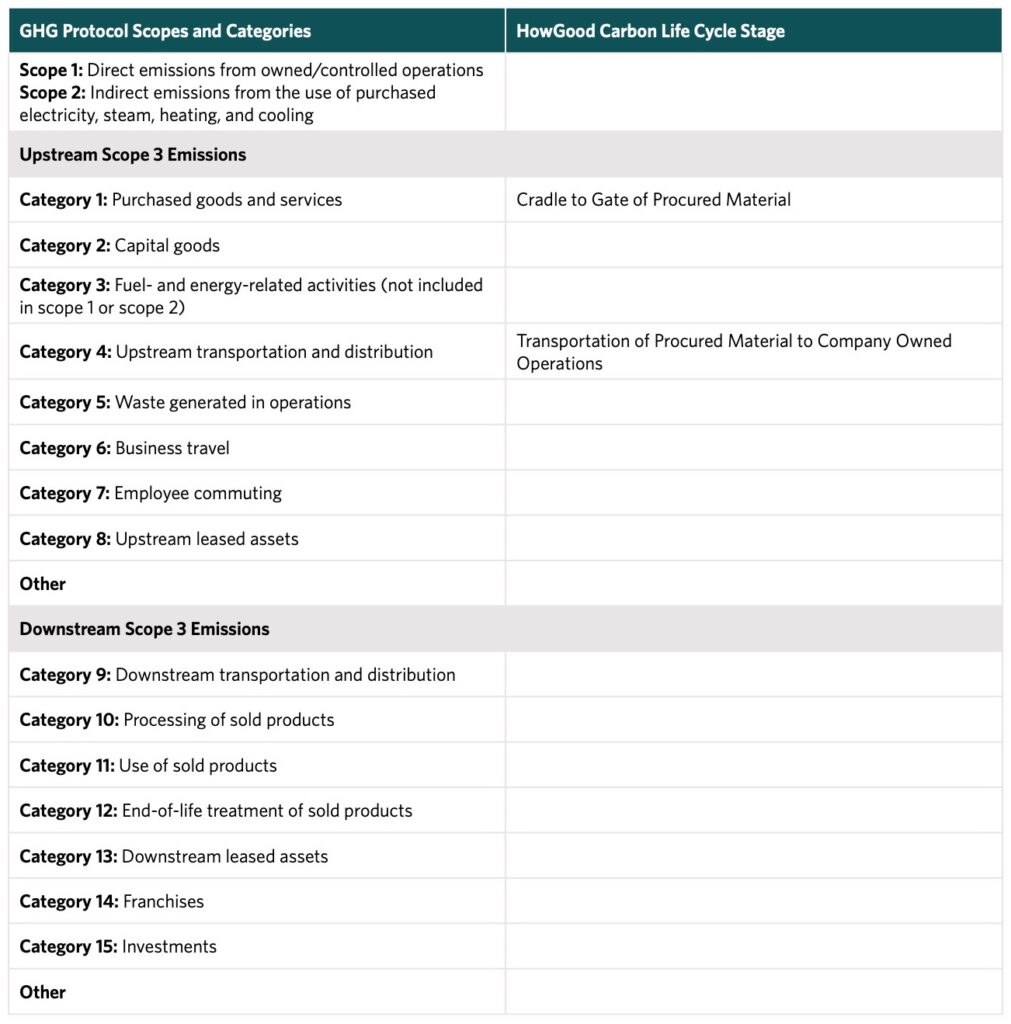HowGood is an independent research company and SaaS data platform with the world's largest database on food product sustainability. With more than 90,000 on-farm emissions factors for food ingredients, HowGood helps leading brands, retailers, suppliers and restaurants to measure, manage, and communicate their environmental and social impact.
Sustainability Reporting
HowGood Methodology for Calculating Scope 3 Emissions
Who is HowGood?
HowGood is an independent research company with the world’s largest database on food product sustainability. With data and analysis for more than 33,000 ingredients, chemicals, and materials, HowGood helps leading food brands, retailers and investors improve their environmental and social impact. Through in-depth, ingredient-level insights on factors ranging from greenhouse gas emissions to animal welfare to labor risk, HowGood data powers strategic decision-making for the sourcing, manufacturing, merchandising, and marketing of sustainable products. Brands identify opportunities to improve sustainability, drive greater transparency, and empower their consumers to make higher impact purchases.
What is HowGood’s approach to research?
HowGood has more than 15 years of research on global food supply chains. The team consolidates and analyzes findings from over 600 accredited data sources and certifications. These include a range of resources such as international frameworks, NGO guidance and standards reports, peer reviewed life cycle assessment studies, journal articles, academic conference proceedings and texts, aggregated commercial databases, targeted industry studies, NGO research, government publications, and news reports from reputable outlets. HowGood employs the most industry-recognized methodologies and incorporates the latest scientific research. Metrics and impact assessments are updated on an ongoing, iterative basis, making HowGood’s platform the leading-edge tool for product sustainability. In turn, HowGood is able to provide impact assessments that are accurate, comprehensive, and the most up-todate. Through HowGood’s sustainability intelligence platform, Latis, we are able to scale this approach across products, brands, and the entire food industry.
What is HowGood’s research methodology for calculating carbon emissions?
HowGood’s methodology for calculating GHG emissions is developed in accordance with the GHG Protocol.
1. Data Collection
HowGood draws on a diverse collection of data sources, including peer reviewed journal articles to calculate the CO2e values for ingredients. For each data source, HowGood performs a data certainty assessment based on the age and comprehensiveness of the findings. This process is completed for every ingredient on which there is accurate and verifiable data.
2. Ingredient Mapping
Once the data is collected and analyzed, HowGood conducts a proprietary process of mapping each ingredient to its source crop, animal or material. Using global import/export data and HowGood industry partnerships, HowGood then maps each source crop to its corresponding geographic location to account for the specific on-the-ground practices, impacts, and risks in each locale. On-farm emissions are multiplied by the ingredient concentration of the product’s ingredient to account for the total amount of material required to grow or raise the ingredient.
3. Data Aggregation
HowGood, to date, has mapped nearly every ingredient, chemical and material (33,000 in total) in the CPG industry, including where and how it is produced. This mapping is used to aggregate data across geographic regions or ingredient categories and develop industry-average impact profiles for CO2e across every ingredient. Based on the ingredient mapping process, HowGood assigns a default location and corresponding industry-average profile for every ingredient in a product. If deeper levels of data granularity are available (from a specific supplier, industry partner, or publication), these specifics are applied.
What data sources does HowGood use to assess GHG emissions?
For GHG emissions, HowGood relies on the International Panel on Climate Change (IPCC) 2013 global warming potential estimates where available and crop-specific LCAs. For crops and locations where no current data exists, HowGood uses supplementary studies and relevant LCAs from proxy locations where environmental conditions and farming methods are deemed as similar.
- Sustainability (Journal)
- International Journal of Life Cycle Assessment
- FAO Database of Greenhouse Gas Emissions from Agriculture
- Journal of Industrial Ecology
- European Space Agency Climate Change Initiative
- Agribalyse
- The Sustainability Consortium
- Journal of Cleaner Production
- Greenhouse Gas Protocol
- USDA LCA Commons Life Cycle Inventory (LCI) database
- United States Department of Agriculture
- Global Logistics Emissions Council
- ESU World Food Database
- Savory Land to Market Ecological Outcome Verification
- Regenerative Organic Certification
- Roundtable on Sustainable Palm Oil
- Palm Oil Innovation Group
- Carbon Neutral
- Soil Carbon Initiative
- EcoCert
- Roundtable on Sustainable Biomaterials
- Rainforest Alliance
- Cradle to Cradle
- Nature Climate Change
- Carbon Neutral Certification
- Life Cycle Data Network
- ReFED Insights Engine
- Global LCA Data Access Network
- World Data Center for Geoinformatics and Sustainable Development
- USDA Ag Data Commons LCA Collection
- Carbon Trust Standard
- World Agroforestry - ICRAF
- Farm Carbon Toolkit
- OpenLCA
- ResourceWatch
- Consultative Group for International Agricultural Research
- Stewardship Index for Specialty Crops
- Carbon Disclosure Project
- Evidensia
- PalmGHG
- AdaptWest Climate Resilience Data Explorer
- Information Processing in Agriculture
- European Life Cycle Database
How does HowGood calculate Scope 3 emissions?
The values provided in HowGood’s Scope 3 Report include emissions due only to sourcing the ingredients tracked within HowGood’s Procurement module. A company may have other sources of Scope 3 emissions due to other operational activities that they should include in their Scope 3 disclosures. The report includes two categories:
- Category 1: Purchased Goods & Services
- Category 4: Upstream Transportation

Source: GHG Protocol Technical Guidance for Calculating Scope 3 Emissions
Category 1: Purchased Goods & Services
Category 1 includes emissions from the cradle to gate of the procured material. For simple ingredients, this is on farm activities, the transportation between the farm and the facility where it is processed into an ingredient, and the emissions due to the processing of the ingredient itself. For complete food products, this includes the on farm activities, the transportation of ingredients between the farm and the facility where they are processed into ingredients, and the emissions due to the processing of the ingredients, transportation to the final product manufacturing facility, and the manufacturing facility itself. In the event that there are multiple processing or manufacturing steps, those additional stages and transportation between them are included as well.

Raw Material Processing into Ingredients
Ingredients are assessed for energy requirements of processing raw materials into ingredients. For example, wheat flour would have all stages of milling energy requirements assessed including washing, grinding, sorting, and sifting (and bleaching when applicable). Excluded from the processing energy value are overhead operations, employee transportation, and manufacturing of the equipment. HowGood then uses the grid mix at the processing location to calculate the associated emissions due to the ingredient processing. HowGood sources these values from papers and reports, LCAs and techno-economic assessments.
In many cases, as it is with some extracts, or supplements, multiple parts of the processing have been accounted for where industry standards can be applied (ex: for safflower extract applies alcohol solvent extraction/spray drying process). We account for each part of the processing where that information is provided or where we can safely make standard processing assumptions. Where this information is not available or assumptions cannot be safely made, and an ingredient has multiple processing types associated, the most energy intensive processing type is used.
We use region grid mix values to determine how much kg CO2e is emitted per unit of energy when the likely fuel to be used in a process is electricity. We have these grid mix values for US states and most countries and are still developing methodology to calculate them for other compound regions (sub-national and supra-national). For fuel types other than electricity (e.g. direct burning of natural gas, coal, biomass etc), we use the carbon intensity of the applicable fuel.
Transportation from Processing Location to Manufacturing Location
This stage covers the emissions due to transportation between the ingredient processing and final product manufacturing locations.
See Transportation from Farm to Processing Facility for details.
Product Manufacturing
Manufacturing is an assessment of the energy it takes for the factory manufacturing needs of a given product.
To calculate GHGs associated with product manufacturing, HowGood uses the product type/sales category and location of the manufacturing facility. Products are grouped into categories based on similar manufacturing processes. Customers can choose the manufacturing type which best describes their product, or HowGood can make a reasonable assumption based on the sales category.
The energy needs of each process or subprocess associated with the production line is collected/estimated from energy or environmental assessments and life cycle inventories as MJ/kg product. They can include refrigeration and lighting but exclude overhead operations, employee transportation, and manufacturing of the equipment. We base our estimates on the manufacturing category of the product (frozen entree, cold case milk, chips & snacks, juice beverages, etc). For example, the manufacturing energy required to make yogurt or kefir would include mixing of ingredients (fruit, etc), culture/fermentation process, sterilization of equipment, sterilization of jar/vessel, heat sealing process, and refrigeration.
HowGood then uses the total energy consumption and the carbon intensity of electricity at the manufacturing location to calculate the associated emissions due to the product manufacturing.
When customers have conducted product LCAs and can provide manufacturing energy data with enough granularity to map to our inclusions and exclusions, we can ingest that data and create a customer and product(s) specific manufacturing type.
See the last paragraph in Processing for limitations and planned changes.
Biogenic Emissions
HowGood has conducted extensive research into the types of processing that are associated with different types of ingredients. This enables us to calculate biogenic CO2e emissions from biofuel combustion associated with any processing or manufacturing machinery used to produce an ingredient. This aligns with SBTi, GRI and CDP reporting requirements and industry best practices, which request information relating to biomass/biofuels.
HowGood’s Scope 3 Report includes a line item separating biogenic emissions from your overall Scope 3 (Category 1) emissions.
Category 4: Upstream Transportation
Category 4 covers the transportation of ingredients between the facility where they are processed into ingredients and the facility to manufacture the final product.

Transportation of Procured Material to Company Owned Operations
To create this metric, we multiply the weight-distance traveled by the emissions factor of the mode of transportation used. We use the Global Logistics Emissions Council (GLEC) framework, a GHG Protocol approved industry framework for global transport emissions accounting and reporting, as our source for emissions factors. Emissions factors are based on tonne-kilometers converted to kg-kilometers to normalize against 1 kg of product maintained in the HowGood database. HowGood customers don’t always have visibility into the methods and distances of transportation between the farm and processing location so HowGood uses proxy data.
Transportation distances are calculated using arc distance calculations between state, country, or region centroids. For inter-region transportation, half the distance across the region is used.
Transportation within North America and intra-region is assumed to be via truck. Transportation within Europe is assumed to be via truck with an EU specific emissions factor. Transportation between other regions is assumed to be via ship.

HowGood
10 Gagnon Dr.
Stone Ridge
NY 12484
© 2024 HowGood.



